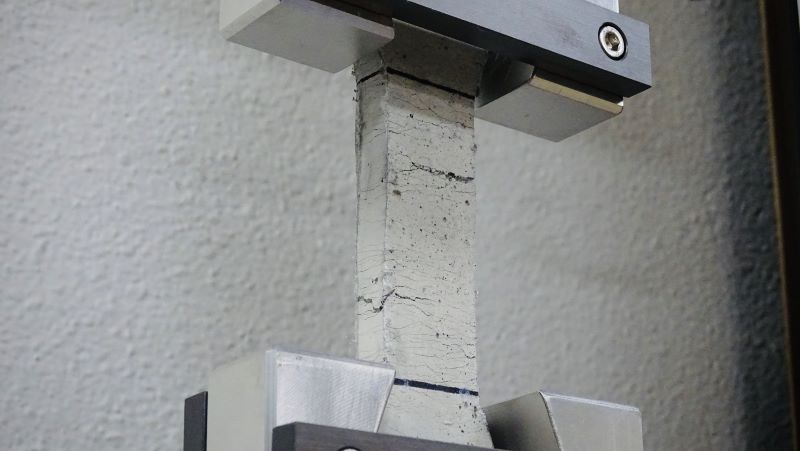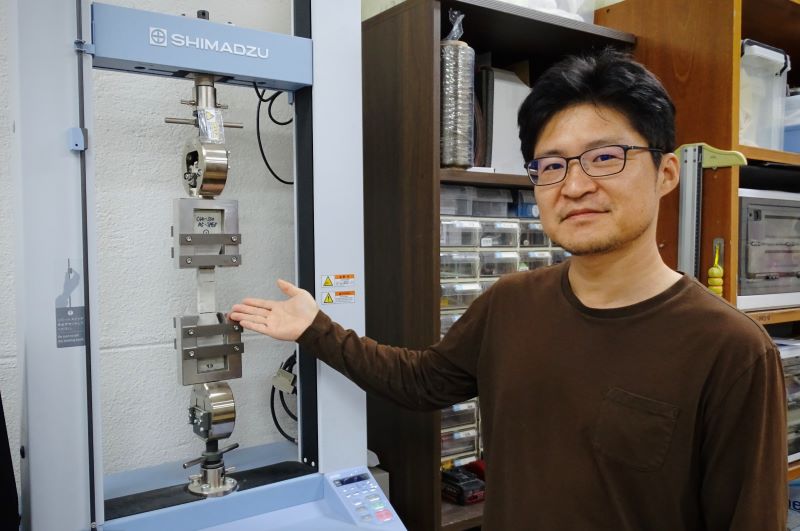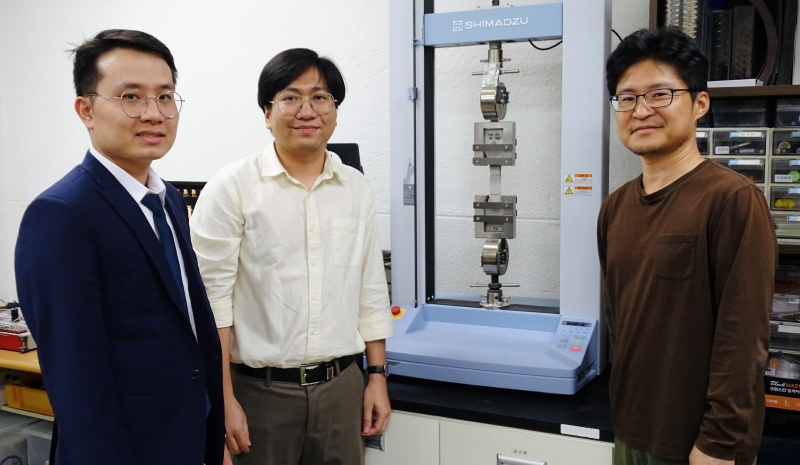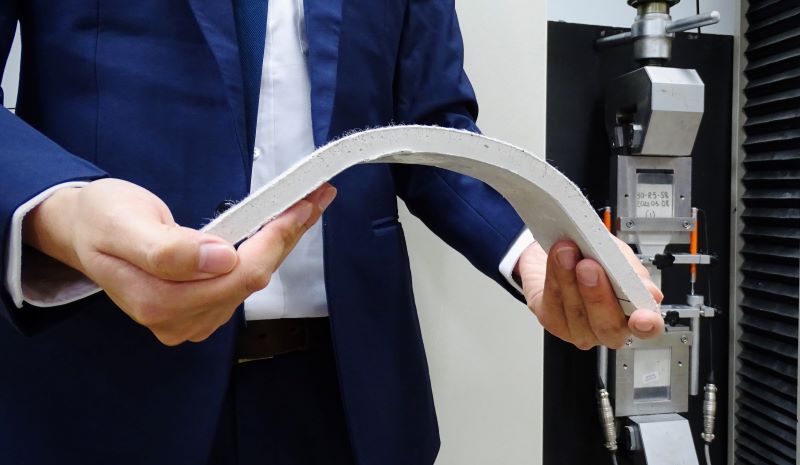Bending Beyond Steel
CNU Professor Lee Bang Yeon Develops World’s Most Bendable Concrete
Interview by Isaiah Winters
Gwangju attracts an impressive array of academics from around the world whose contributions often go unnoticed. To shed some light on just one area where Gwangju leads the world, I wound up at Chonnam National University’s Advanced Building Materials Lab headed by Professor Lee Bang Yeon who, together with his research team of graduate students, is perfecting a unique type of eco-friendly bendable concrete with a deformation capacity the world has never seen. What follows is our interview there.
Isaiah Winters (IW): Thank you for taking the time to discuss your cutting-edge research on environmentally friendly bendable concrete. Few may know that Gwangju’s Chonnam National University has one of the world’s leading labs for advanced building materials. So, to fill our readers in, please introduce yourself and talk about your lab’s position at the forefront of this revolution in building materials.
Lee Bang Yeon (Professor Lee): I joined the School of Architecture at Chonnam National University in 2011 and have been conducting research on concrete, the most widely used construction material. Concrete is an economically viable construction material, with relatively high strength and durability. It is the most frequently used construction material alongside steel. Concrete’s performance can also be easily adjusted by selecting its constituent materials and varying their proportions in the mixture. However, concrete has inherent drawbacks, such as low tensile strength and brittle behavior (deformation capacity: 0.01%). This arises from the fact that concrete is composed of inorganic materials similar to glass and ceramics. Therefore, steel rebar, which exhibits ductile behavior with a deformation capacity over 15%, and concrete should be used together in buildings and infrastructures. The research focus of our lab is to develop new high-performance concretes that overcome the shortcomings of conventional concrete and to elucidate the mechanisms behind their superior performance. So far, our research has yielded world-class achievements in the areas of highly ductile fiber-reinforced concrete, eco-friendly concrete, and high damping concrete.
IW: Can you give us an idea of just how much stronger your patented bendable concrete is compared to regular concrete? What makes it so strong, and what else can it do that traditional concrete cannot?
Professor Lee: We developed a novel bendable concrete – technically known as highly ductile fiber-reinforced concrete – that possesses a deformation capacity of up to 22% of its original length. This performance is 2,200 times higher than that of normal concrete (0.01%) and even higher than that of steel rebar (15%). The research findings have been published in a prestigious academic journal, Ceramics International: “Quang-Hiếu Lương, Huy Hoàng Nguyễn, Phương Hoàng Nguyễn, Su-Tae Kang, Bang Yeon Lee (2023) Extremely-ductile alkali-activated slag-based composite with a tensile strain capacity up to 22%”. To develop this new bendable concrete, crumb rubber (recycled rubber produced from automotive and truck scrap tires) powder was incorporated into the mortar (a mixture of binder, water, and sand), and polyethylene short fibers were reinforced at a volume ratio of 1.75%. A new mixing method and curing method were developed to enhance the performance of the bendable concrete. The new mixing approach ensures a more homogenous dispersion of fibers, resulting in the exceptional deformation capacity observed in our new bendable concrete.

IW: Talk about the eco-friendly benefits of bendable concrete. What materials are recycled in the production process, and how does this new form of concrete reduce emissions?
Professor Lee: Every year, over 1 billion scrap tires are improperly discarded. Because tires are non-biodegradable, a proper solution to dispose of waste tires is paramount. Furthermore, the burning of waste tires without proper handling contributes to air and soil pollution. Adding to the environmental concerns, around 8% of all carbon dioxide emissions comes from cement production. To address this, crumb rubber particles and alkali-activated slag (a by-product of the steelmaking process) were used in our newly developed bendable concrete for the improvement in deformation capacity and material greenness. The new bendable concrete not only has superior structural performance compared to normal concrete and previous high-performance concrete, but it is also eco-friendly, with reduced carbon dioxide emissions and embodied energy. These environmental attributes were evaluated using material sustainability indicators.
IW: Besides these advantages, what other significant benefits can bendable concrete have around the world?
Professor Lee: The repair and rehabilitation of aged and deteriorated structures have become important issues in the field of construction. In addition, the magnitude and frequency of both natural and man-made disasters appear to be growing. To try and address these issues, there is a need for technological advances that improve either the condition or performance of existing structures. Bendable concrete has been developed to meet this technical demand. It can be used in structures subjected to extreme loads due to natural (earthquakes, hurricanes, tsunamis, etc.) or man-made disasters (terrorist attacks, explosions, collisions, etc.) because it has high deformation capacity and toughness (energy absorption capacity).
IW: Of course, we would be remiss if we did not address the drawbacks of using bendable concrete, like the high cost. As we saw during the Hwajeong I-Park collapse, construction companies are always looking to cut costs by relying on subcontracting and cheaper materials. Therefore, what might prevent construction companies from using bendable concrete?
Professor Lee: Bendable concrete has a high deformation capacity and toughness that surpasses normal concrete by hundreds of times. Even when cracks occur, the width of these cracks is smaller than the thickness of a human hair (about 100 micrometers), making the concrete more resilient and durable for use in buildings and infrastructures. However, in order to achieve such performance, high-performance synthetic fibers must be used, and as a result, the price of the concrete we developed is about 10 times higher than that of normal concrete due to the high cost of the fibers. Additionally, specialized equipment and techniques must be employed to manufacture it, and the variability in strength and deformation capacity is higher than that of normal concrete due to the reduced homogeneity and orientation of fibers included in the bendable concrete. Although the newly developed bendable concrete may not be practical at this juncture, our achievement is noteworthy in terms of establishing the feasibility of attaining extremely ductile behavior, surpassing 22% in concrete – again, higher than the deformation capacity of steel rebars used in reinforced concrete. We will continue to conduct research not only to improve the performance of bendable concrete, but also to reduce the cost and variability of performance to facilitate its practical application.

IW: Bendable concrete is not just used for new construction projects, but also for reinforcing and retrofitting existing structures. How feasible is this, and are there any well-known buildings in the world that have been retrofitted or reinforced with bendable concrete already?
Professor Lee: Bendable concrete has been widely applied to both new and existing buildings, as well as civil infrastructures. Notable instances include the repair of the Mitaka Dam in Japan, the spray repair of irrigation channels in the Western U.S., China, and Japan, retrofitting of the Japan Rail tunnels in Japan, the patch repair of bridge decks in the U.S., retrofitting of bridge decks and road pavement link-slabs in Michigan and Virginia, U.S., retrofitting of viaduct dampers in Japan, and the use in coupling beams (typically added to a structure to improve its lateral force resistance) in structures like the 27-story Glorio Tower, 41-story Nabule Yokohama Tower, and 60-story Kitahama Tower in Japan. The application methods for bendable concrete are as versatile as those for conventional concrete, encompassing self-consolidating on-site casting, spraying, precasting, injection pumping, and hand troweling.

IW: Gwangju is very fortunate to have such a forward-thinking lab right here at home. Have any local businesses or government institutions expressed interest in your research?
Professor Lee: As previously mentioned, bendable concrete, with its high deformation and energy absorption capacity, is highly resistant against extreme loads such as those induced by earthquakes, tsunamis, and acts of terrorism. In Korea, where the incidence and intensity of natural and human-caused disasters are relatively low, there exists a limited awareness of the need for bendable concrete. However, thanks to the R&D funding provided by the Korean government, we have been able to develop bendable concrete with the world’s best deformation capacity of 22%. Recently, the Engineering & Construction group at SAMSUNG C&T asked me to give a presentation on the newly developed bendable concrete, and we engaged in discussions regarding its future practical applications.
IW: What is next for your lab and its research? Also, is there anything you would like to add that we have not already addressed?
Professor Lee: Upon becoming a professor at Chonnam National University, one of my goals was to develop bendable concrete with a deformation capacity greater than 10%. At that time, most bendable concrete exhibited a deformation capacity of about 3%. As highlighted earlier, we achieved far beyond my goal by developing a new bendable concrete with a deformation capacity of up to 22%. Moving forward, our lab plans to conduct research on the practical application of various versions of the bendable concrete we have formulated. We plan to incorporate alternative recycled fibers to mitigate costs, optimize the material and formulation to reduce performance variability, and automate the manufacturing method so that it can be applied to real buildings and civil infrastructures.
IW: You must be proud of your research lab’s exceptional results. I wish you great success as you continue to perfect the world’s most ductile concrete, saving lives and the environment in the process.



Professor Lee Bang Yeon (center) and his team of researchers in front of the School of Architecture Building at CNU
The Interviewer
Isaiah Winters is a guy in Gwangju whose curiosity leads him to places way beyond his depth, like advanced building materials labs. When he is not embarrassing himself by asking stupid questions to far smarter people, he is either working, proofreading the Gwangju News, or seeking novelty somewhere in Korea.





